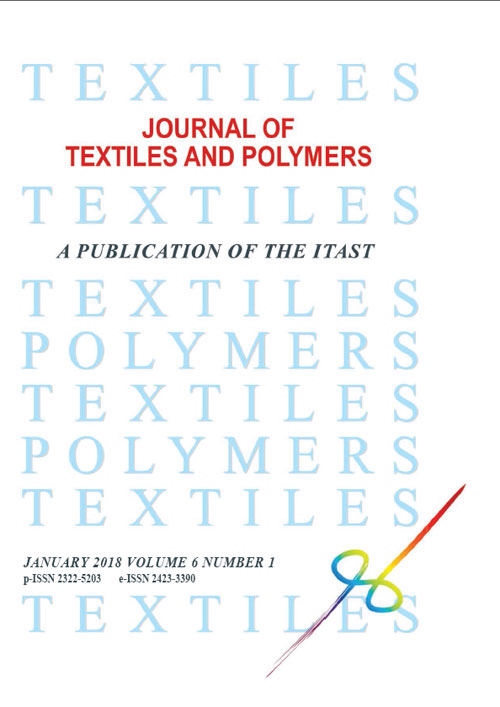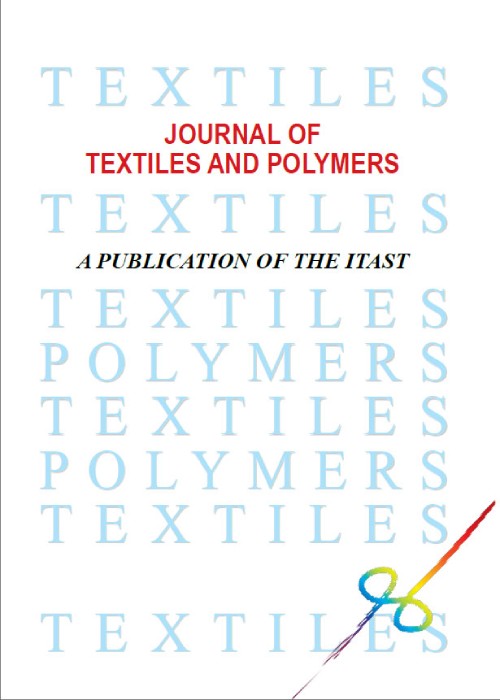فهرست مطالب

Journal of Textiles and Polymers
Volume:6 Issue: 1, Winter 2018
- تاریخ انتشار: 1397/02/16
- تعداد عناوین: 7
-
-
Pages 3-8Natural-synthetic polyblend nanofibrous scaffolds have attracted numerous research interests in regenerative medicine due to their high cell compatibility and appropriate biological, physical and mechanical properties. In the current study, poly(caprolactone)-chitosan-poly(vinyl alcohol) (PCL: Cs: PVA) nanofibrous blend scaffolds were prepared and their biological properties were investigated. In our previous studies we found a high efficacy in healing on rat and dog models for PCL: Cs: PVA nanofibers. In this study, the cell compatibility of scaffold was examined using MTS method and its high biological properties in cell adhesion and proliferation were proved. The scaffold shelf life was also studied using FTIR and DSC methods as well as cell culture test. The results showed that after one-year post-fabrication, the chemical bonds, thermal behavior and cell viability of scaffolds did not change obviously, so the minimum expiration time of the scaffold was found to be about 1 year. The in vitro degradation was also investigated by tracking the rate of weight loss at different time points in PBS solution in a 37 ºC incubator under mild shaking. A 90% weight loss was observed for the scaffold after 6 weeks in PBS solution. As a result, the PCL: Cs: PVA nanofibrous web due to its high biological properties and appropriate shelf life and biodegradation time is a good candidate to be used in medical applications.Keywords: nanofibrous scaffolds, chitosan, poly(caprolactone), scaffold degradation, shelf life
-
Pages 9-14In this work, the recovery property of machinemade carpet was investigated using the viscoelastic models. Viscoelastic modeling of textile materials are usually performed with presenting different combination of spring and dashpot. Two different mechanical models including linear and nonlinear Jefferys mechanical model were analyzed and compared. Static loading was applied to the samples for a certain time. The load was then removed and recovery behavior was investigated. The experimental data were then adapted to the theoretical data using curve fitting based on least square method. The results showed that there was a reasonably good agreement between the Jeffreys models and experimental data. The reason is that these two models are not completely elastic showing secondary creep. No significant difference was observed between linear and nonlinear model. The speed of recovery at the removal of the static loading was also analyzed. The results show that the nonlinear Jefferys model indicates less value of speed of recovery at zero time in comparison to the linear model. The recovery of cut pile carpers shows some permanent creep and is explained by nonlinear and linear Jefferys model acceptably.Keywords: cut pile carpet, static loading, recovery, viscoelastic models, thickness loss
-
Pages 15-21Hairiness is one of the most important parameters affecting fabric quality in textile industries. Up to now, many researchers have focused their studies on the hairiness and its related concepts. It is well known that fiber properties affect hairiness, nevertheless, spinning machine parameters which are also effective on hairiness are not well studied before. In this study, the prediction ability of hairiness by taking account of the variables including rotor type, rotor diameter, doffingtube nozzle and torque-stop was studied using support vector machine (SVM) and adaptive neuro fuzzy interface system models. Moreover, the genetic algorithm was applied to ensure that the model parameters were optimized correctly. Then, the obtained results were compared with those provided by artificial neural network (ANN) and it was revealed that all models had the great potential to be used in hairiness prediction (mean absolute percentage error = 3.8-3.9). The performances of SVM and ANN models were almost the same, however, they were better than that of fuzzy model.Keywords: hairiness, machine parameter, support vector machine, adaptive neuro fuzzy interface system, genetic algorithm
-
Pages 23-30One of the common moisture management methods is to use a multilayer fabric structure which is capable to facilitate moisture transfer through fabrics. The present work aims at investigating the rate of liquid transfer through nanofiber-coated yarn as the sewing threads attaching two layers of fabric (hydrophobic/hydrophilic). Visual observations were carried out to make a comparison among vertical wicking rises in the nanofiber-coated yarns and the conventional yarns, The effects of voltage parameters, number of filaments per yarn and solution concentration on the height of wicked water were investigated. The highest rate of wicking belonged to the PAN nanofiber-coated yarn prepared at a voltage of 18 kV. Then, two layers of hydrophobic and hydrophilic fabrics were joined using nanofiber-coated yarns as the sewing threads to investigate the rate of liquid transfer through bilayer fabrics. The average liquid transfer in fabric was obtained by estimating the rate of reduction of the size of water droplet which was placed on the sewn thread on the hydrophobic fabric. The size of each droplet was measured at every 0.03 s, accurately. The coated yarn in compare to the conventional yarn showed higher rates of moisture transfer from the hydrophobic to the hydrophilic fabric.Keywords: moisture management, bi-layer fabric, wicking, liquid transfer, nanofiber-coated sewing thread
-
Pages 31-37To control noise pollution, the sound intensity should be reduced to a level comfortable for humans. The use of textile products especially with porous structures for noise absorption applications is one of the most widely used methods of noise reduction. Therefore, in this study the acoustical properties of porous woven fabrics based on noise reduction coefficient (NRC) and noise absorption coefficient (NAC) were evaluated. Effects of weft density and type of porous yarns, namely hollow and micro-porous yarns and also hollow yarns hole size at different frequencies were studied. Analysis of variance and Duncan test at 95% confidence level were performed to evaluate the difference between the acoustical properties of samples statistically. The results determined that weft density and yarn type had a significant effect on acoustical properties of woven fabrics. In addition, fabrics woven by micro-porous yarns showed a better noise reduction procedure.Keywords: hollow yarn, micro-porous yarn, acoustic properties, woven fabric
-
Pages 39-45Nowadays, fiber-reinforced concrete plays a vital role in the construction industry due to its superior mechanical properties, corrosion resistance, and light weight characteristics.Thanks to the partial penetration of fine-grained concrete within the bundle of fibers, ductile behavior of fiber-reinforced concrete can be anticipated. In this capacity, the bundle of fibers is divided into two distinct areas namely, the fibers embedded into concrete,which is called as sleeve fibers, and dry fibers which are supposed to behave as core fibers. Accordingly, estimating the number of sleeve fibers and distinguishing their damages when the fiber-reinforced concrete is subjected to load service are the main scopes of this study. Electrical resistance of roving was measured by Wheatstone bridge technique to detect fiber damage during bending of fiber-reinforced concrete beam. Besides, the number of sleeve fibers on the roving cross-section was estimated using SEM images and was correlated with the changes in the electrical resistance of roving. The results indicate that the sleeve fibers fail with a distinctive delay after the occurrence of the first crack, while the core fibers remain sound. Eventually, it is demonstrated that the proposed methodis capable of estimating the number of damaged fibers during bending test, and also evaluating the penetration of the cement matrix within the bundle of fibers.Keywords: fiber-reinforced concrete, damage detection, electrical resistance, carbon fibers
-
Pages 47-53One way to improve the properties of staple yarns is to employ corecompact yarn spinning system. This type of yarn is used in a wide range of applications and up to now many researchers have studied its production process and properties. However, there is a lack of researches regarding the optimization of the properties of rotorcraft compact spinning (RoCos) core-spun yarns based on the spinning parameters. Therefore, in this paper, the influence of some spinning parameters including the pre-tension of filament, yarn count and type of sheath fiber on the properties of RoCos core-spun yarns was investigated. To achieve the goals of this research, the physical and mechanical properties of RoCos core-spun yarns including the tenacity, hairiness and abrasion resistance were measured, and then modeled by artificial neural network (ANN). Finally, to optimize all measured properties at the same time the ANN models and non-dominated sorting genetic algorithm (NSGAII) method were applied as a hybrid model. The results showed that the presented method could be successfully used to determine the spinning parameters to produce RoCos yarns with desired properties. The optimized values of hairiness, tenacity and abrasion resistance for an ideal yarn were observed at yarn count of 41.5 tex, filament pre-tension of 125 g and for sheath fiber of viscous/polyester.Keywords: rocos, core-spun yarn, artificial neural network, non-dominated sorting genetic algorithm, multi-objective optimization


